I admit, I’d grown cynical. Dragon Age has a well-established penchant for swapping out protagonists with each new game, and for treating one entry’s be-all, end-all conflicts as little more than narrative springboards that can largely be cast aside in the next. However, with 2014’s Inquisition, it seemed more vital than ever that BioWare not do this, as the studio ended that game with a devastating cliffhanger that saw your hero, the Inquisitor, locked in a battle of ideals with Solas, the elven mage party member who, at the game’s conclusion, is revealed to be an elven god. Surely, I thought, switching to a new protagonist now and sidelining the hero through whom we’d become so engaged in this conflict would result in a failure to do right by this story I’d been waiting a decade to see conclude. I’m happy to say I was wrong. When I rolled credits on Dragon Age: The Veilguard, I felt something I hadn’t felt for Dragon Age in a long time: hope.
Don’t get it twisted. The Veilguard is full of contrivances as it contorts itself to justify leaving the hero who started this war behind. Though they do appear in the story, as BioWare has publicly confirmed, this is the second time that the series has effectively taken one hero’s struggle and put it on a new protagonist’s shoulders, and as these stories have only grown more personal, the fact that a new hero has to rise up in each game has become harder to swallow. The Veilguard’s relative disinterest in previous cross-game continuity is obvious from the moment you open the character creator and see that only three choices from previous games are implemented into its story. But that disinterest doesn’t come at the expense of players’ world state integrity, as BioWare truly goes out of its way to never bring up any character or plotline that isn’t directly tied to what’s going on in new protagonist Rook’s field of view.
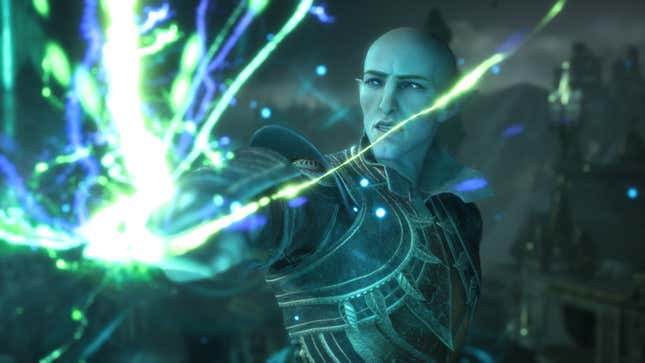
Even without substantial choice carry-over, Dragon Age: The Veilguard feels like the culmination of everything the series has gestured at in previous games. It’s a grand tour of places we’ve only heard of since Dragon Age: Origins and delves into lore concepts that have persisted in the background for years. It pulls this off while wrapping up a decade-long cliffhanger in a way that lived up to my expectations. In place of constant, direct references to what the player has done in games more than 10 years old, The Veilguard feels like a recentering for both the franchise and BioWare as a studio. It’s not the story I wanted, but it feels like one well-suited to give the series a fresh start.
The Veilguard starts years after Inquisition’s Trespasser DLC, in which Solas, having abandoned his team at the end of the main game, reveals his intention to tear down the Veil, a barrier between the real world and the demon-infested Fade, to re-expose the elven people to its magic so they can regain their long-lost immortality. Rook, a new hero recruited by fan-favorite storyteller Varric Tethras, uses their local expertise to guide our old friend to a ritual site in the northern territories of Thedas, where Solas is attempting to finally make good on his threat. At least, that’s what the situation appears to be, initially. According to Solas (crucially also known as the Dread Wolf and the elven god of lies), he wasn’t trying to destroy the Veil…yet. He was attempting to move two of the “Evanuris,” elven gods imprisoned behind the construct, as he carried out his plans. However, Rook and Varric’s meddling with his ritual has unleashed these two tyrannical menaces onto the world and trapped Solas within the Fade, where he is left with only weak connection to communicate with Rook. The god puts the onus on them to stop the Evanuris from subjugating the rest of the world under their eons-long delusions of grandeur.
I have my problems with Rook as a character forcefully injected into a conflict that isn’t theirs, but to its credit, The Veilguard feels in conversation with that disconnect. Though it took several hours for me to be satisfied with its explanations, I don’t think the game would have landed for me if it wasn’t at least cognizant of what it would mean to trade heroes this time. Early on, it felt like everyone, Varric especially, would insist that Rook was the person for the job, citing the character’s mercenary history—determined by you—as evidence that they’re a powerful piece on the metaphorical chess board. While no one ever calls him by his real name, my Rook is a Tevinter mage named Emil Mercar. He is part of the Shadow Dragon revolutionary group fighting to eradicate slavery in the country, so he naturally has connections in Tevinter that would make him a decent merc for hire. But are those the makings of a leader? What place does he have in a fight against actual gods when heroes who have fought against these odds before are likely better suited for the job?
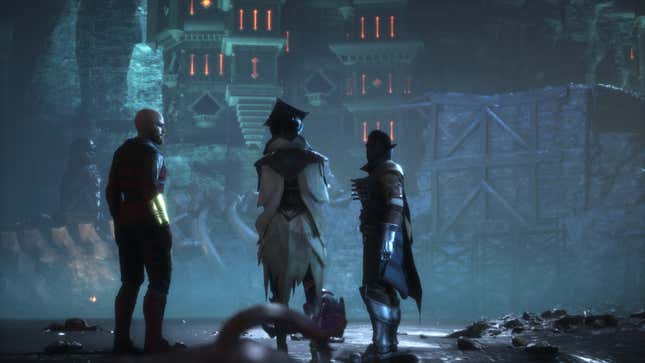
The answer, for my Rook, was that a leader doesn’t lose sight of the people who follow them and who rely on their success. When I picked the Shadow Dragons as my faction, my Rook’s history and ideals started forming in my head, and The Veilguard constantly communicated that Thedas needed someone like him fighting for change. It was a refreshing feeling coming back to Dragon Age years later and shifting from the self-serving character I’d played in Inquisition and the absolute chucklefuck I was in Dragon Age II to this more noble hero. It was an affirmation of how I’ve changed, but also of how Dragon Age has evolved for the better. Most BioWare games put you in the center of the universe, and have you manipulating figureheads and bending entire cultures to your whims. The Veilguard feels less malleable than previous games, but its choices feel more personal, as if the game actually believes in something and wants you to react to it, rather than breaking and rearranging itself into whatever you want it to be like a toy that’s just designed to make you feel powerful and satisfied.
Some will likely be disappointed by that shift from more earth-shattering choices to more personal ones. But having seen the series turn nuanced disputes into binary choices paved in violence, it feels good to have a game that doesn’t sand down entire cultures into factions that then just get swallowed up in other fights. I was much happier to nudge Neve, the mage detective and my comrade in the Shadow Dragons, to be a hopeful figure for the people of Tevinter, and to help my Grey Warden lover Davrin embrace his newfound role as a caretaker for a flock of once-extinct griffins, than I was resolving the geopolitical conflicts of the world with the wave of a hand. It was these connections with my party members that pulled me in, as The Veilguard’s main plot mostly left me cold for large swaths of my roughly 60-hour first playthrough, with the elven gods driving it feeling like abstract enigmas of evil and Solas taking a backseat until key climactic events. It was easier to just primarily focus on who I was working with than the “why.” The Veilguard is largely a series of more intimate vignettes, with some major lore reveals lodged in the spaces between if you go looking for them. At least until its final hours, when the plot kicks into high gear and the finale starts delivering on all the prior buildup.
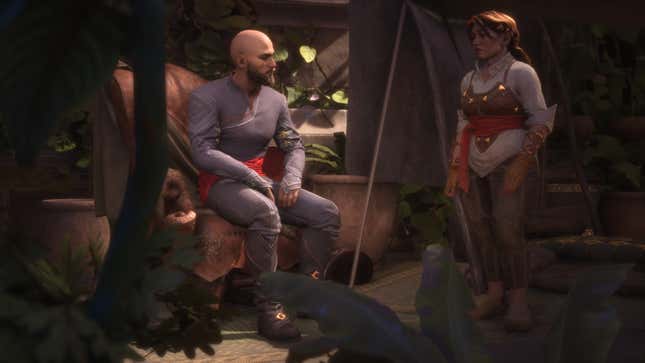
That isn’t to say that The Veilguard is lacking in world-shaking stories and choices. Its companion stories alone dive into some mysteries that have lingered in the background of the franchise for years. Scout Harding, a supporting character in Inquisition who here carries on the Dragon Age tradition of such a character getting promoted to party member, delves into some major dwarven lore that I was thrilled to discover, given they are often the most underserved race in the series. Bellara, the elven Veil Jumper who is fascinated by her people’s history, can set a course for their future. Emmrich, a necromancer, explores death as a cultural concept within the Dragon Age world above all else, rather than just offering another meditation on grief that could take place in any universe.
Most of The Veilguard’s biggest decisions come from the relationships Rook creates with the people around them, and they have a broader impact than the game makes clear upfront. When BioWare announced it was changing the game’s subtitle from Dreadwolf to The Veilguard to decenter Solas and reflect the game’s focus on the new cast, I was skeptical because of my investment in that story from a decade ago. But The Veilguard truly does feel like a character-focused story similar to the one BioWare gave us in Mass Effect 2. The party parallels between the two series feel calculated and manifest in some truly stunning moments for its heroes. Though some previous Dragon Age party members still hold the top spots in my heart, The Veilguard’s collection of companions is perhaps the most consistently engaging one BioWare has given us yet in this franchise. As I talked to this crew, I had trouble envisioning any of them fading into relative obscurity as some characters from Origins and Inquisition have over the years. Even the characters who I didn’t gravitate toward, like Bellara and the possessed assassin Lucanis Dellamorte, made an impression on me by the end.
This is the first time a Dragon Age party has felt like a found family to me. I found fewer points of tension within the group, and even when I’d done something that could have been a dealbreaker for one of my teammates, it felt easier to smooth over than before. There are some standout haters and rivalries, but less of the whole “actively wishing death upon each other” thing than before. I was consistently surprised by the forms that relationships would take in The Veilguard, and how supportive the group was of one another as they dealt with their own shit. Romance blooms between members of the group, and I was delighted to give advice and cheer them on as they supported my relationship with Davrin in kind.
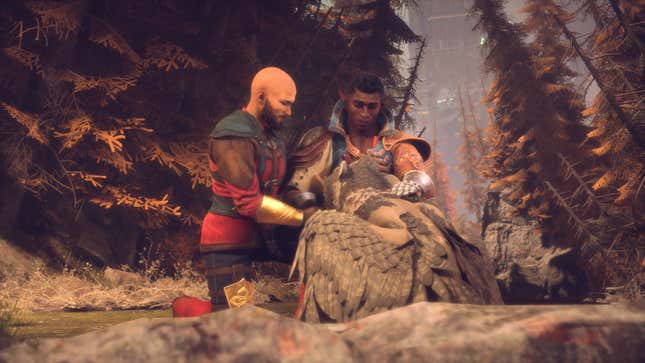
Wrapped up in all these relationships is a concerted effort to create something that feels like it draws, culturally and identity-wise, from a diverse cast in the Dragon Age universe. You can pursue romance with any party member regardless of your Rook’s gender or race, and those that I didn’t pursue found love in other places, both with each other and with characters we met on our adventures. The Veilguard’s expansive character creator also allows you to pick a non-binary identity and pronouns and give your character top surgery scars, and in the game itself, you’re allowed to explicitly declare that your Rook is trans and talk about that with other characters. Much of this is couched in Dragon Age’s own lore and the cultures of its world, and these choices, if you take them, are treated as more than mere footnotes on a character sheet. BioWare has often been seen as a force for more inclusive game design and storytelling in big-budget games, and The Veilguard feels like the most thorough the studio has ever been in letting you be who you want to be and explore that identity within the boundaries of its world.
Speaking of characters, I have to address the Inquisitor’s role in all this, so if you don’t want to know anything about that, skip the next four paragraphs. Like Inquisition before it, The Veilguard hands you a character creator and lets you remake your old hero so they can appear throughout the game. Dragon Age II’s Hawke was given the same treatment in Inquisition, accompanying you through a whole major story questline before promptly fucking off in the opposite direction, never to be heard from again (or getting trapped in the Fade depending on your decisions, but I digress).
The Inquisitor, meanwhile, is pretty much a non-presence throughout most of The Veilguard. They show up a few times with a half-hearted explanation for why they’re cool leaving their archnemesis (or friend, or lover) to Rook, then they, too, throw up a peace sign and dip for several hours before stopping by to tell you to keep up the good work. Even as I spent my time getting to know Rook’s crew and growing to care for him as I had every other Dragon Age protagonist, the reminders that dealing with Solas shouldn’t have been his story cut deep. I could live without references to the wars I’d settled and the people I met in the south. What bothered me most was every time someone reminded me that Solas was in my head and that the looming threat of his plan haunted my every nightmare, I thought not of the title “Inquisitor,” but of August Trevelyan, my own particular Inquisitor, the mage I left behind 10 years ago because this is Dragon Age. This is how things have always been, thus how they must always be.
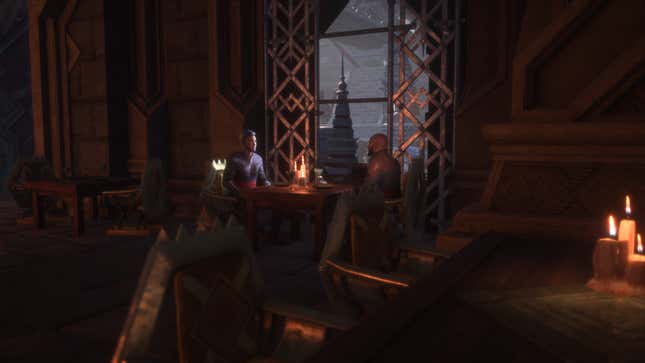
The Veilguard’s relative separation from the past feels more calculated than those divisions have felt in prior Dragon Age games. Even without a lot of choices carrying over, its overarching story still feels like a solid continuation of what’s come before, despite it having to bend itself nearly to its breaking point to put Rook at the center. The old choices it does choose to import are more personal, as they’re used to color in the lines of a flattened Inquisitor. But there are no shades of my resentful atheist thrust into a holy war. Even his decision to disband the titular group, a choice that I made out of exhaustion and defiance, is merely a footnote in the short stories he tells my Rook. But he still adores his lover fighting for Tevinter’s freedom and, despite everything, views Solas as a friend worth saving. It’s like I can see all those intricacies behind his eyes as he speaks, but I have to accept that I’m no longer steering them.
By the time The Veilguard was properly unveiled, I’d come to terms with the fact that I wouldn’t be playing as the hero who should have led the charge against Solas. I had spent the decade between games knowing the shift was coming. Perhaps the Inquisitor’s minimal presence gave me the space to grow attached to Rook and fill in how he would be different from my last Dragon Age character. But every time I met up with the Inquisitor, I was reminded that the character who, ten years ago, I imagined would be facing Solas was just a puppet dragged out of a closet, a half-assed fulfillment of an obligation BioWare seems unwilling to completely make good on. I miss you, August. But I hope I don’t see you again in the next Dragon Age. I don’t think my heart could take it.
While I miss the Inquisitor, I do not miss the structure of his game. Dragon Age: The Veilguard’s hard breaks from the past take many forms, and perhaps the most pronounced is that it feels more evocative of a Mass Effect than a Dragon Age. Your mileage may vary on that score, but having watched BioWare bury what it does best underneath open-world and live-service trends over the past decade, having a game go back to basics is one of the most heartening things it could have done.
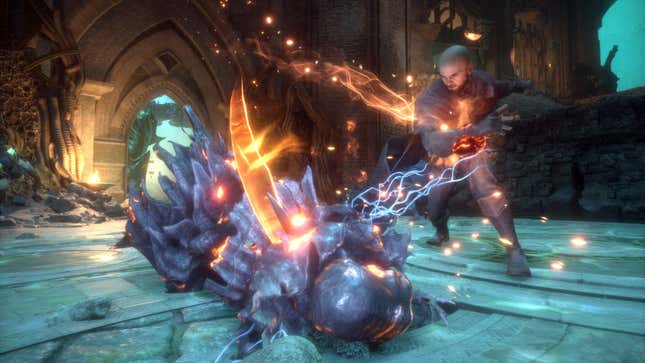
The Veilguard abandons Inquisition’s open zones for a more streamlined mission structure complete with reasonably large areas to explore that stop short of being overwhelmingly vast. The upshot is that I rarely felt like The Veilguard was wasting my time as I tried to get to the good shit. Sure, there are a few collectibles here and there, but the smaller spaces feel intentional, the missions found in them memorable, and the battles I took on were involved and often challenging. Going back to smaller spaces sounds like a net win for everyone, but the pivot from tactical real-time combat to straight-up action is going to be the most divisive part about The Veilguard, given the series’ tactical roots. Dragon Age has been gradually moving towards action with each successive entry, but The Veilguard drops the tactical facade altogether. It’s still an RPG with builds, skill trees, tactics, and party compositions, but it’s traded overhead perspectives and controlling your party members for something that borders on a character action game. And y’all, it whips.
The Veilguard’s Mass Effect influence feels most obvious in its combat, which has Rook and two teammates operating with only a handful of abilities at a time, rather than a dozen spells at your disposal. My Rook is a mage, a class which has been overhauled for action-oriented combat with the option to switch between a standard long-range staff and a mid-range orb-and-dagger. I chose to wield the orb and dagger, allowing me to fight comfortably at a distance in the early sections of the game by magically throwing the orb back and forth like a boomerang at enemies, then whipping out my blade as they got too close for comfort. As I progressed down my skill tree, I chose the Spellblade specialization that complemented my playstyle with devastating close-range attacks that made me a force to be reckoned with in a scrap. I was pleased to see how much specializations could drastically alter playstyles, especially in an action game that could easily devolve into button mashing without nuances to make it strategic.
That being said, while your team does mostly adhere to the same warrior/mage/rogue archetypes of previous games, the distinctions between the three feel less important than what abilities your party has on hand. You don’t control your party, and they can’t fall in battle, making them mostly cooldown machines to support Rook. For most of the game I ran with Davrin and Neve. Davrin is a warrior, but he doesn’t function quite like a tank would in previous games. Instead, he has abilities that give me brief tank-like qualities like invulnerability, which in turn buy Neve or myself time to heal me up to get back into the fight. Like warriors in other Dragon Age games, Davrin can taunt foes to take the heat off of others (Rook in this case), but as I worked down his skill tree, that same ability gained supportive properties like healing Rook over time. Almost everything your party does in The Veilguard funnels back into supporting you, which makes some sense because this is the first time a Dragon Age game hits you with a game over if your protagonist falls in battle.
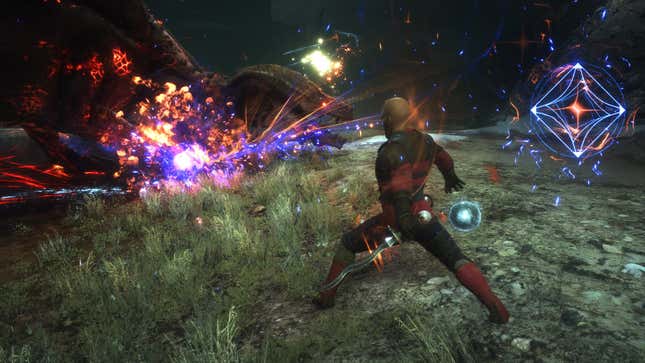
While it would be easy to pick apart the ways The Veilguard is different from its predecessors, the game’s pivot to action RPG doesn’t feel half-baked. Party synergy is less about classes than it is about understanding what niche a companion fills, and once I discovered how creating different party makeups could bring about new strategies, I found a lot of freedom in freely swapping between characters without being beholden to any one composition. Neve has healing magic, but she also has an ice-based kit that allows her to freeze and shatter foes with a flick of her wrist. Davrin is my tank, but he was also my detonator, bringing in his pet griffon Assan to follow up a spell with a swift aerial attack, creating an explosive reaction. After my team had unleashed a powerful area-of-effect explosion, I would dash in and clean house. In The Veilguard, my combat strategies formed and unfolded within seconds, and as I unlocked new abilities and found new complexities, along with acquiring special weapons with interesting effects, I appreciated how fun and experimental its systems could be.
Trying to sum up my thoughts on Dragon Age: The Veilguard gives me an uncertain feeling in my gut. I know this game will be disappointing to those who feel it’s not enough of an RPG or who didn’t feel like their past choices were represented enough. I know that some people might feel similarly to me: let down by the narrative in the early hours but taking solace in the chance to make connections with other characters. For some, that might not be enough to push through and reach what I think is BioWare’s best ending in nearly 20 years, one that delivers on the promise the game offers at the start.
There’s a conversation late in The Veilguard in which the Inquisitor asks Rook what they think of Solas. By this point, Rook has learned enough about him to have formed their own nuanced opinion of the Dread Wolf. But you’re asked to sum up whether you believe him to be an absolute bastard, or a misguided savior ravaged by guilt. Some of those feelings will likely be informed by your past relationships with him as another hero. I said that he had his heart in the right place, but I could feasibly see anyone answering either way. Much like Solas himself, Dragon Age: The Veilguard feels primed to be a divisive figure depending on the frame of reference one brings with them. Some will view it as a return to form, others might feel it’s a step too far from the tactics-oriented gameplay that made them such ardent fans of the series in the first place.

For me, having watched BioWare flounder as it chased the success of other studios, The Veilguard feels like the team playing the hits in some ways. It narrows its focus to a cast of well-rounded heroes, meaningful relationships, and rich world-building, with choices that feel close enough to home that they don’t have to be kicked down the line to the next game to be impactful. What could have felt like a panicked return to safety instead feels like a measured attempt to remember what made the studio so renowned in the first place. The Veilguard pulls off old tricks with a level of polish unlike anything the studio’s done before. There will inevitably be division and scrutiny around every choice BioWare made, but Dragon Age: The Veilguard represents the first time in many years I’ve played a game from this studio that didn’t leave me worried about the future. Instead, I’m ready to look forward to it once more.


